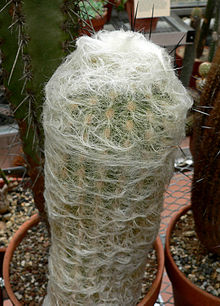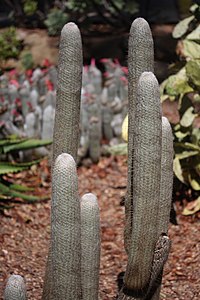| This article relies largely or entirely on a single source. Relevant discussion may be found on the talk page. Please help improve this article by introducing citations to additional sources. Find sources: "Espostoa lanata" – news · newspapers · books · scholar · JSTOR (May 2017) |
| Espostoa lanata | |
|---|---|

| |
| Espostoa lanata var. gracilis | |
| Scientific classification | |
| Kingdom: | Plantae |
| Clade: | Tracheophytes |
| Clade: | Angiosperms |
| Clade: | Eudicots |
| Order: | Caryophyllales |
| Family: | Cactaceae |
| Subfamily: | Cactoideae |
| Genus: | Espostoa |
| Species: | E. lanata |
| Binomial name | |
| Espostoa lanata (Kunth, 1823) Britton & Rose, 1920 | |
| Synonyms | |
|
Cactus lanatus Kunth | |

Espostoa lanata is a species of cactus of the genus Espostoa.
Its common names are Peruvian old man cactus, cotton ball cactus, snowball cactus, snowball old man.
Habitat
Its original habitat is from southern Ecuador to the northern Peru on the west slopes of the Andes mountains.
Description
Espostoa lanata is a columnar cactus. It looks like Cephalocereus senilis (the Old Man of Mexico) : it is a densely hairy species, covered by a warm woolly coat and well adapted to high altitudes. It is widespread in its habitat and quite variable in size and spines, and for this reason it has received several names.
The plant is a column up to 7 meters tall in the wild, but only 3 meters when cultivated. The diameter is from 5 to 20 cm. There are 18 to 25 ribs. The ribs and the sharp central spines are mainly hidden by the woolly radial spines. It branches only after several years.
It flowers at night from a lateral cephalium after several years.
Woolly hairs have been used for pillow filling in Peru.
Subspecies
- Espostoa lanata subsp. lanata
- Espostoa lanata subsp. huanucoensis (H.Johnson ex F.Ritter) G.J.Charles synonym Espostoa huanucoensis F.Ritter
- Espostoa lanata subsp. lanianuligera (F.Ritter) G.J.Charles synonym Espostoa lanianuligera F.Ritter
- Espostoa lanata subsp. ruficeps (F.Ritter) G.J.Charles synonym Espostoa ruficeps F.Ritter
Cultivation
Source :
Espostoa lanata is easy to grow. It needs fertile and well-drained soil. In summer, water the plants well but allow them to dry before watering again. Use monthly a fertilizer for cacti.
In winter, keep it dry and the temperature may be as low as −12 °C, but it is better to keep it without frost.
The exposure must be sunny in summer and at least luminous in winter.
In favorable conditions (sun, water, large place), it can grow 20 cm every year.
References
- "Espostoa lanata (Peruvian Old Man Cactus)". World of Succulents. 16 May 2017. Retrieved 11 February 2021.
- ^ "Espostoa lanata". www.cactus-art.biz. Retrieved 11 February 2021.
| Taxon identifiers | |
|---|---|
| Espostoa lanata |
|
| Cactus lanatus | |